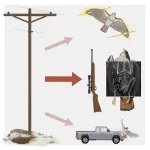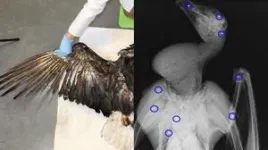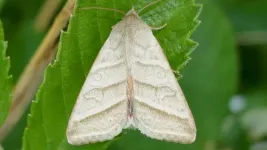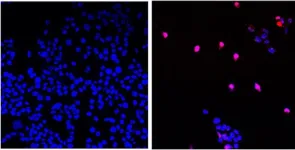(Press-News.org) Birds can be electrocuted if they come into contact with two energized parts of a power line at once—which can happen when they spread their wings to take off from or land on a power pole. Because of this, energy companies invest substantial time and money into making sure power lines are avian safe, installing safe perches and insulating energized elements. However, a recent study published on August 1 in the journal iScience presents a new priority for conservation, as it suggests that electrocution is no longer the only leading cause of death for birds along power lines. Instead, researchers report that 66% of dead birds that were found along power lines—for which a cause of death could be conclusively determined—died from being illegally shot.
“Solving conservation problems only works when we can accurately identify the cause of those problems,” says first author Eve Thomason, a research associate at Boise State University’s Raptor Research Center. “In this case, we need to know how birds are dying along power lines so that we can come up with strategies to reduce bird deaths.”
Before starting this research project, Thomason used to perform avian risk assessment for a power company. There, she noticed that she was finding dead birds even along power lines where they should have been safe from electrocution. That’s when she realized that many had been shot, which prompted her to organize a more complete investigation to study how common this shooting pattern was. Over the course of four years, her team hiked or drove along 196 kilometers of power lines in Wyoming, Idaho, Utah, and Oregon in search of dead birds. They collected a total of 410 carcasses, most of which were federally protected species such as eagles, hawks, and ravens. They then took them back to a laboratory to determine each bird’s cause of death.
“What’s unique to our study is that all remains were documented, collected, and X-rayed. We tried to identify the cause of death for every bird we found,” says Thomason. “Prior studies typically only documented birds that were in relatively good condition, and X-rays were only sometimes performed.”
By X-raying all remains, the researchers were able to more accurately identify bird shootings even when the manner of death was not externally apparent from the carcass. For example, the team examined a bald eagle that a power line owner thought had died from electrocution. However, when they X-rayed the bird, they identified numerous shotgun pellets and entrance wounds throughout the eagle’s body, suggesting that the bird was actually shot and then made contact with power lines as it fell to the ground.
The team is planning on continuing their power line surveys and expanding into new areas so they can understand the spatial extent of illegal shooting and see whether there’s a reason why birds are being shot. This provides helpful information for law enforcement as they plan patrols or investigations to prevent this illegal shooting from continuing.
"We are just beginning to understand this problem, and in a lot of cases, it’s really difficult to know what’s going on,” says Thomason. “Here’s what the research tells us: when people have been caught doing this activity, we’ve learned that sometimes people shoot protected birds for fun, and sometimes they’re trying to protect their livestock from predators. Because of the complexity of this situation, our team is very lucky to have such great relationships across all the government agencies and utility companies, and it will be vital that, in the future, all these stakeholders are part of crafting solutions.”
###
This study was supported by the Idaho Army National Guard, Avian Power Line Interaction Committee, US Fish and Wildlife Service, US Bureau of Land Management, the Raptor Research Center at Boise State University, and US Geological Survey. Information about conflicts of interest can be found in the text of the paper.
iScience, Thomason et al. “Illegal shooting is now a leading cause of death of birds along power lines in the western USA” https://www.cell.com/iscience/fulltext/S2589-0042(23)01351-2
iScience (@iScience_CP) is an open-access journal from Cell Press that provides a platform for original research and interdisciplinary thinking in the life, physical, and earth sciences. The primary criterion for publication in iScience is a significant contribution to a relevant field combined with robust results and underlying methodology. Visit: http://www.cell.com/iscience. To receive Cell Press media alerts, contact press@cell.com.
END
Media contacts:
Coby Schal, coby@ncsu.edu
Mick Kulikowski, News Services, 919.218.5937 or mick_kulikowski@ncsu.edu
Aug 1, 2023
Male Moth ‘Aphrodisiac’ Revealed
EMBARGOED FOR RELEASE UNTIL 11 A.M. EDT ON TUESDAY, AUG.1
North Carolina State University researchers have identified the specific blend of pheromone chemicals – including a newly revealed aphrodisiac – used by male moths during courtship as they attempt to entice females to mate. The findings provide more detail ...
Bottom Line: The U.S. Preventive Services Task Force (USPSTF) recommends that all persons planning to or who could become pregnant take a daily supplement containing 0.4 to 0.8 mg (400 to 800 μg) of folic acid. Neural tube defects are among the most common congenital malformations in the U.S., with an estimated 3,000 pregnancies affected each year. Many of these neural tube defects are caused by low folate levels in the body. The USPSTF routinely makes recommendations about the effectiveness ...
About The Study: The results of this study suggest that providing fair and equal access to health care may reduce the disparities in treatment outcomes between Black and white patients with advanced prostate cancer.
Authors: Neeraj Agarwal, M.D., of the University of Utah in Salt Lake City, is the corresponding author.
To access the embargoed study: Visit our For The Media website at this link https://media.jamanetwork.com/
(doi: 10.1001/jamanetworkopen.2023.26546)
Editor’s Note: Please see the article for additional information, including other authors, author contributions and affiliations, ...
About The Study: The findings of this secondary analysis of a randomized clinical trial suggest that exercise is a promising treatment for chemotherapy-induced peripheral neuropathy (CIPN) and incorporating exercise program referrals into the standard oncology care may reduce CIPN symptoms and increase quality of life for survivors of ovarian cancer.
Authors: Anlan Cao, M.B.B.S., of the Yale School of Public Health in New Haven, Connecticut, is the corresponding author.
To access the embargoed study: Visit our For The Media website at this link https://media.jamanetwork.com/
(doi: 10.1001/jamanetworkopen.2023.26463)
Editor’s ...
LOS ANGELES — Researchers at City of Hope, one of the largest cancer research and treatment organizations in the United States, today published a new study explaining how they took a protein once thought to be too challenging for targeted therapy, proliferating cell nuclear antigen (PCNA), and developed a targeted chemotherapy that appears to annihilate all solid tumors in preclinical research. As the scientists continue to investigate the foundational mechanisms that make this cancer-stopping pill work in animal models, they note that ...
Millions of Americans with tobacco-related lung disease have symptoms that do not fit any existing tobacco-related disease criteria – including the most common of those, chronic obstructive pulmonary disease (COPD) – according to a new study led by researchers at UC San Francisco.
In a study publishing Aug. 1, 2023, in the Journal of the American Medical Association (JAMA), the research team found that half of the participants with extensive tobacco exposure had a persistently high level of respiratory symptoms, including shortness of breath, daily cough and ...
Para-cresol is an aromatic compound with a strong horse stable-like odor. It contributes to the off-flavor of some foods, but it is also detectable as a characteristic odorant in whiskey and tobacco, as well as in the urine of various mammals. A research team led by the Leibniz Institute of Food Systems Biology at the Technical University of Munich has now discovered which odorant receptor humans use to perceive para-cresol.
Para-cresol (4-methylphenol) is formed during the microbial degradation of certain amino acids, but also during thermal ...
A large natural experiment in Catalonia shows that moving to areas with higher levels of air pollution is associated with weight gain in young children. The study, led by the Barcelona Institute for Global Health (ISGlobal), an institution supported by ”la Caixa Foundation”, in collaboration with the IDIAP Jordi Gol, provides further evidence to support efforts to reduce air pollution.
Overweight and obesity in childhood result from the interaction of genes, lifestyle behaviours, physiological and social factors. Environmental exposures such as air pollution may ...
Aug. 1, 2023
Contact: Derek Smith, 734-546-3632, smitdere@umich.edu
Katherine McAlpine, 734-647-7087, kmca@umich.edu
Images
Cracking in lithium-ion batteries speeds up electric vehicle charging
Cracks in predominant lithium-ion electrodes shorten battery lifespans, but a neuroscience-inspired technique shows that they have an upside
ANN ARBOR—Rather than being solely detrimental, cracks in the positive electrode of lithium-ion batteries reduce battery charge time, research done at the University of Michigan shows.
This runs counter to the view of many ...
INDIANAPOLIS – Periodontal disease is a growing public health issue in the United States as the nation’s population ages, yet it’s underdiagnosed and undertreated. According to the U.S. Centers for Disease Control and Prevention (CDC), 47 percent of adults aged 30 years and older and 79 percent of adults 65 years and older have some form of periodontal disease.
Researchers from Regenstrief Institute and Indiana University School of Dentistry have developed computer algorithms to track periodontal disease change, which could help dentists and periodontists follow disease progression. They also have developed tools to ...




